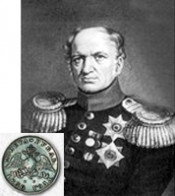
G. F. Cancrin currency reform began
In the first third of the 19th century financial system of the Russian Empire reached a critical point. The main reason was frequent and unjustified issue of paper bank notes which were not secured and devalued quickly.
In 1839-1843 under the guidance of Minister of Finance Georg von Cancrin the currency reform was carried out. It was intended to streamline Russian monetary system.
On July 1 (13), 1839 the Manifesto “On the monetary system arrangement” was signed and made public. According to the document the main purchasing coin was henceforth a silver coin of Russian coinage and invariable monetary unit – a silver ruble.
All the deals with state treasury and private individuals were to be concluded on silver basis as well as the calculation of national income and expenses, turnover of lending institutions, etc. State bank notes became auxiliary notes of value and for them was established a compulsory and invariable silver rate: 1 silver ruble = 3 rubles 50 copecks in bank notes. The rate of golden and copper coin was also fixed.
In order to realize the switch to a new system a reserve in gold and silver was made within the following four years owing to buying up of golden and silver coins and bars as well as to the increase of quantity of domestic mining of precious metals. Thus in the course of the reform a hard credit ruble was introduced secured by golden and silver coins. As to copper coins, they became the money of exchange.
At the same time the Depositary of silver coins under the State Commercial Bank was established. Each holder of silver could submit it to the depositary and receive in return Depositary notes. Depositary notes with a face value of 3, 5, 10, 25, 50 and100 rubles were declared a legal means of paying.
Owing to depositary notes, which were 100% secured by silver, the government was trying to restore the confidence in soft money, accumulate the supply of silver in the state treasury and prepare the ground for introduction of the soft money of full value.
The currency reform was completed in 1843 with the issue of new soft money – banknotes secured by silver which enjoyed confidence among the population.
Lit.: Гусаков А. Д. Денежное обращение дореволюционной России. М., 1954; Друян А. Д. Очерки по истории денежного обращения России в XIX в. М., 1941. С. 5—34; Мельникова А. С., Уздеников В. В., Шиканова И. С. Деньги в России. История русского денежного хозяйства с древнейших времён до 1917 г. М., 2000. Гл. 3. С. 224; То же [Электронный ресурс]. URL: http://www.bonistikaweb.ru/KNIGI/dengi-melnikova-4-3.htm; Левичева И. Н. Денежная реформа 1839-1843 гг. // Вестник Банка России. 1999. № 65; Мотревич В. П. Министр финансов Е. Ф. Канкрин и денежная реформа 1839-1843 гг. в Российской империи // Бизнес, менеджмент и право. 2003. № 4; То же [Электронный ресурс]. URL: www.bmpravo.ru/show_stat.php?stat=243;
Based on the Presidential Library’s materials:
Взгляды русского министра первой половины XIX cтолетия. СПб., 1866;
Гурьев А. Н. Денежное обращение в России в XIX столетии: исторический очерк. СПб., 1903;
Мигулин П. П. Русский государственный кредит (1769-[1906]). Харьков, 1899. Т. 1;
Мигулин П. П. Наша банковая политика (1729-1903). Харьков, 1904;
Шипов А. П. Очерк жизни и государственной деятельности графа Канкрина. СПб., 1864.

